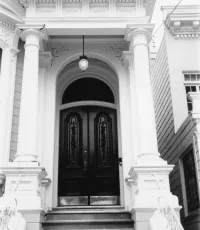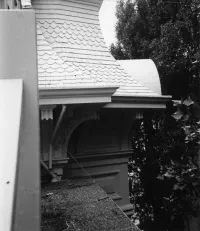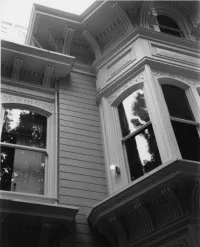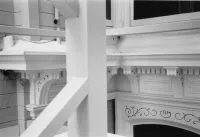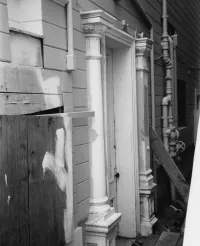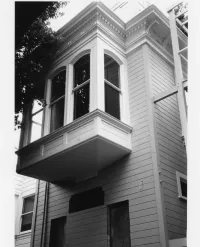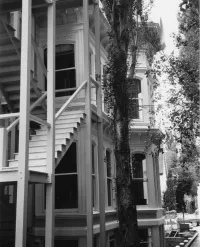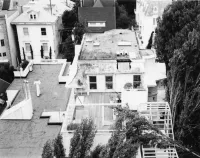Share what you know,
and discover more.
Share what you know,
and discover more.
Apr 19, 1984
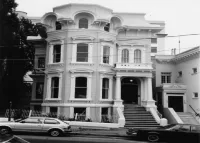
-

- Charmaine Bantugan
Dallam-Merritt House - National Register of Historic Places
Statement of Significance: The Dallam-Merritt House is one of San Francisco's very few surviving luxury residences built about 1870 as most such dwellings were destroyed by the ^eat fire of 1906. This house escaped because in 1900 it had been moved outside the area that later burned. The owners who moved it, Dr. George Washington Merritt and Dr. Emma Sutro Merritt, significant persons in S^ Francisco's medical history, resided in the house both before and after the move and made additions which still stamp the building's character. Dr. Emma Merritt in particular is outstanding as a prominent early woman physician, as a worker in the woman's movement, as executor of the estate of her millionaire father the former mayor Adolph Sutro, and as a benefactor in her own right. The house's earliest residents, Richard B. Dallam and Alsop J. Holmes, were prominent respectively in San Francisco manufacturing and Western miming. The building itself is an unusual example of Second Empire and Italianate styles, especially remarkable for the shape of its Mansard roof and for Merritts matched the Italianate ornamentation in their 1900 additions. The site of the future Dallam-Merritt House, a 37ix87i-foot lot at the northeast comer of Sutter and Mason streets, was recorded sold on Thursday 15 January 1869 by Charles Main, of the noted Western saddlery firm Main & Winchester, to Armes & Dallam, importers of willow ware and manufacturers of wooden ware and brooms. The $7,675 price reflected the lot's expected use as a luxury residence. Within one block there were or were soon to be the elegant homes of: clothing manufacturer Isidor Barroilhet, Pacific Mail Steamship agent “Capt.” Oliver Eldridge, Ralston's partner and rival William Sharon, capitalist Alexander Boyd, real estate tycoon Edward Barron, and commission merchant Raphael Gallejos of Montealegre & Company-quite a cosmopolitan group of neighbors. By the April, 1871, San Francisco Directory (but not in its immediate predecessor of December 1869), Richard Boothby Dallam had moved into his children. The June 1870 Census taker had not found them there; so, the house must have been completed in late 187O or early 1871. Probably designed by a good architect, the building must have been one of 711 structures with the San Francisco Bulletin reported in Mid-December 1870 were under construction or had been completed and occupied in the previous six months. The article said, "The dwelling houseware Sf various styles of architecture. Most of them are two or three stories high, are approached by raised steps and have bay windows." It does not mention Mansard or French roofs, but the then-current Directory had noted two such roofs, remarking that historian H. H. Bancroft's "third story will be finished in the now-prevailing style for mansions, with a Mansard attic roof, giving a rural appearance."3 The next Directory explained the prevalence of frame buildings "from the fear of earthquakes, also from the more pleasant and healthful character of such structures, their economy and facility of ornamentation, the confidence and . efficiency of the Fire Department and the low rates" for fire insurance. The same volume carried a full-page ad for Armes & Dallam's "wood and willow ware, twines, baskets, brushes, paper bags, etc., Armes' Star Extra Broom . . . cog wringers."5 Newly established in his fashionably located small frame mansion, Richard Dallam must have felt expansive to pay for such an ad. Bom in Kentucky in 1824, educated in St. Louis, trained as a wood-turner and experienced in the Mexican War, ' Dallam had been a forty-niner and an 1856 Vigilante. In 1857 his sister married George W. Armes, who with his brother Charles Armes had grown the first broom com in California. In 1859 the three men bought out the 1852 firm of Hauxhurst & Son and began their importing of willow ware and their local manufacture of wooden household items. Dallam's share was to supervise the factory, in the Vigilance Committee's building 1859-1864, later on Davis Street. In 1876, in order to use convict labor, Armes & Dallam moved its factory inside San Quentin prison, and Richard Dallam sold his Sutter Street house for $30,000, later moving to Oakland near his partners. The buyer was Alsop Joseph Holmes (b. New York State 1820), a peripatetic miner and builder of quartz mills. After successfully developing the mining district of Esmeralda County, Nevada, he retired to San Francisco, realized a fortune selling part interest in his Northern Belle Mine, and bought the Dallam House. He is probably responsible for its first addition in the rear. Six months after the purchase he married, and settled in at 528 Sutter at least into 1883. The next known owners were the Merritts, who occupied the house at least by 1888, rented other quarters 1893-1900 and leased this house to other physicians as offices. They moved the house and added to it in 1900, lived in it I9OI-I913, and retained ownership until their heirs sold it in 1950. Before the Merritts purchased the present site on Washington Street, the new lot had been occupied by a stable, first erected by Augustus Starr for his livery stable business about 1874, rented to John Peters 1877 to 1881, run by Starr again I883-I884, and then by William Rayhill. The I893 Sanborn map shows a nearly square, X-marked building the full width of the lot but less than half its depth; it's labeled "Milk Depot." (Previous identification, of 2355 Washington as what the Newsome built for an A. M. Starr in 1886 appears incorrect.) About 1894 Augustus Starr sold the lot to Charles G. Graeber, a butcher on Fillmore Street a couple blocks away. Graeber sold to the Merritts, who pulled down the old stable to make way for their still older house. Dr. George Washington Merritt (1855-1928) was born in Hawaii, came to California in 1857» went to school in Los Angeles, graduated from San Jose State Normal School in 1878, took his M.D. at the University of California in 1882 and interned at San Francisco General Hospital. In London in I883 he married Emma Sutro, whom he had met in medical school, and they studied together for four years at the Ecole de Medicine in Paris. Though their specialties differed, he protected her from harassment by attending lectures and clinics with her. They returned to San Francisco, were certified to practice on the same day, 3 August 1887» and took up residence at the comer of Sutter and Mason. At first, he carried on his eye, ear, nose and throat practice there, later he rented office space elsewhere. He helped manage his father-in-law's properties. About 1896 he joined the University of California Medical School staff and became chief of its ophthalmological clinic in 1899. After the house had been moved to Washington Street, he built an early medical office building at the Sutter and Mason site, conducting his own office on its fourth floor. After the 1906 earthquake and fire he resigned from the Medical School but became more identified than ever with the Polyclinic, both as staff and as board member and president. Bilingual from his Los Angeles childhood, he made much use of Spanish in his profession. Later in life he was a director of the Down Town Association and of the Civic League of Improvement Clubs, active in local betterment long after he had retired from medicine. Dr. Emma Sutro Merritt (1856-1938) was born and educated in San Francisco, graduated from Vassar College in 1877 took her M.D. at the University of California in I88I and proceeded to Europe for further study. Her father was Adolph Sutro, creator of the tunnel that drained the Comstock mines in Nevada. The year after her graduation from Vassar he completed this tunnnel and sold out for about a million dollars, much of which he wisely invested in undeveloped land in the western part of San Francisco, owning about one-tenth the acreage of the whole city. Thereafter he managed his holdings, collected the country's fourth largest private library, built Sutro Baths and his own mansion in a best statue garden overlooking the ocean and his Cliff House, and gave liberally to public causes, including donation of the thirteen acres on which the University of California San Francisco now stands. He was mayor of' San Francisco 1895-1897* As his oldest child, Dr. Emma Merritt was executor of this vast estate, her duties having begun in 1897 as his court-appointed guardian, when she took him into her home for his final year of illness. In the 1906 fire, when Capt. Murphy's firemen were about to dynamite the Montgomery Block where part of her father's library was stored, she prevailed upon them instead to save the library, and also the building, which stood until 1959 a proud reminder of pioneer days. She and the other heirs subsequently gave the Sutro Library to the State, and the Sutro Baths to the City. In 1913 the Merritts moved from Washington Street to her father's mansion above Cliff House. With the reservation that she lives out her life there, she deeded to the city that house and its grounds, now Sutro Heights Park, but the City demolished the building. Professionally Dr. Emma Sutro Merritt played an important role in the local history of women physicians. While not among the true pioneers— the California Medical Society had admitted its first five women members while she was still at Vassar—she joined the staff of Children's Hospital immediately upon her return from Prance in 1887, when the twelve-year-old institution, begun, staffed and funded by women to serve women, first moved to its present location on California Street. In 1891 she was one of eight physicians the hospital listed. Dr. Merritt had charge of medical and surgical diseases of children there for some twenty years, serving like Children's other staffers without pay. Her private practice office was at her home address, first in the Dallam Merritt House on Sutter, then in various rented quarters, then in the subject house again after it was moved to Washington Street. In city directories she and Dr. George Merritt had equal and separate bold—face listings. In I893 when Children's wanted a Milk: Laboratory to treat cow's milk for bottle-fed babies, Adolph Sutro donated $250 to the project and Dr. Emma established it in the basement of their rented home. Less than two years after the introduction of serum treatment for diphtheria, in 1896, she read to the San Francisco Medical Society a paper on "The Differential Diagnosis of Diphtheria." Concerned with new procedures, the paper was well received, and she may have given others. She continued practicing, though probably at a reduced rate, into the 1920s, when she was in her sixties. Dr. Emma made other contributions to the women's movement. First, she convinced her father and husband to support equal rights for women. The two Merritts practiced medicine as partners for 45 years. In addition, Davis says that in I89I Dr. Emma lobbied the State Legislature for the right of women to vote in school elections, a measure that passed the Legislature only to be vetoed by the Governor. Davis also says she participated in the Woman's Congress or Pacific Woman's Congress that took place in San Francisco 20-26 May 1895> attracting Susan B. Anthony, Rev. Anna Shaw, and women from all over the West. They were officially and enthusiastically welcomed by the Mayor, Dr. Emma's father.
Dallam-Merritt House - National Register of Historic Places
Statement of Significance: The Dallam-Merritt House is one of San Francisco's very few surviving luxury residences built about 1870 as most such dwellings were destroyed by the ^eat fire of 1906. This house escaped because in 1900 it had been moved outside the area that later burned. The owners who moved it, Dr. George Washington Merritt and Dr. Emma Sutro Merritt, significant persons in S^ Francisco's medical history, resided in the house both before and after the move and made additions which still stamp the building's character. Dr. Emma Merritt in particular is outstanding as a prominent early woman physician, as a worker in the woman's movement, as executor of the estate of her millionaire father the former mayor Adolph Sutro, and as a benefactor in her own right. The house's earliest residents, Richard B. Dallam and Alsop J. Holmes, were prominent respectively in San Francisco manufacturing and Western miming. The building itself is an unusual example of Second Empire and Italianate styles, especially remarkable for the shape of its Mansard roof and for Merritts matched the Italianate ornamentation in their 1900 additions. The site of the future Dallam-Merritt House, a 37ix87i-foot lot at the northeast comer of Sutter and Mason streets, was recorded sold on Thursday 15 January 1869 by Charles Main, of the noted Western saddlery firm Main & Winchester, to Armes & Dallam, importers of willow ware and manufacturers of wooden ware and brooms. The $7,675 price reflected the lot's expected use as a luxury residence. Within one block there were or were soon to be the elegant homes of: clothing manufacturer Isidor Barroilhet, Pacific Mail Steamship agent “Capt.” Oliver Eldridge, Ralston's partner and rival William Sharon, capitalist Alexander Boyd, real estate tycoon Edward Barron, and commission merchant Raphael Gallejos of Montealegre & Company-quite a cosmopolitan group of neighbors. By the April, 1871, San Francisco Directory (but not in its immediate predecessor of December 1869), Richard Boothby Dallam had moved into his children. The June 1870 Census taker had not found them there; so, the house must have been completed in late 187O or early 1871. Probably designed by a good architect, the building must have been one of 711 structures with the San Francisco Bulletin reported in Mid-December 1870 were under construction or had been completed and occupied in the previous six months. The article said, "The dwelling houseware Sf various styles of architecture. Most of them are two or three stories high, are approached by raised steps and have bay windows." It does not mention Mansard or French roofs, but the then-current Directory had noted two such roofs, remarking that historian H. H. Bancroft's "third story will be finished in the now-prevailing style for mansions, with a Mansard attic roof, giving a rural appearance."3 The next Directory explained the prevalence of frame buildings "from the fear of earthquakes, also from the more pleasant and healthful character of such structures, their economy and facility of ornamentation, the confidence and . efficiency of the Fire Department and the low rates" for fire insurance. The same volume carried a full-page ad for Armes & Dallam's "wood and willow ware, twines, baskets, brushes, paper bags, etc., Armes' Star Extra Broom . . . cog wringers."5 Newly established in his fashionably located small frame mansion, Richard Dallam must have felt expansive to pay for such an ad. Bom in Kentucky in 1824, educated in St. Louis, trained as a wood-turner and experienced in the Mexican War, ' Dallam had been a forty-niner and an 1856 Vigilante. In 1857 his sister married George W. Armes, who with his brother Charles Armes had grown the first broom com in California. In 1859 the three men bought out the 1852 firm of Hauxhurst & Son and began their importing of willow ware and their local manufacture of wooden household items. Dallam's share was to supervise the factory, in the Vigilance Committee's building 1859-1864, later on Davis Street. In 1876, in order to use convict labor, Armes & Dallam moved its factory inside San Quentin prison, and Richard Dallam sold his Sutter Street house for $30,000, later moving to Oakland near his partners. The buyer was Alsop Joseph Holmes (b. New York State 1820), a peripatetic miner and builder of quartz mills. After successfully developing the mining district of Esmeralda County, Nevada, he retired to San Francisco, realized a fortune selling part interest in his Northern Belle Mine, and bought the Dallam House. He is probably responsible for its first addition in the rear. Six months after the purchase he married, and settled in at 528 Sutter at least into 1883. The next known owners were the Merritts, who occupied the house at least by 1888, rented other quarters 1893-1900 and leased this house to other physicians as offices. They moved the house and added to it in 1900, lived in it I9OI-I913, and retained ownership until their heirs sold it in 1950. Before the Merritts purchased the present site on Washington Street, the new lot had been occupied by a stable, first erected by Augustus Starr for his livery stable business about 1874, rented to John Peters 1877 to 1881, run by Starr again I883-I884, and then by William Rayhill. The I893 Sanborn map shows a nearly square, X-marked building the full width of the lot but less than half its depth; it's labeled "Milk Depot." (Previous identification, of 2355 Washington as what the Newsome built for an A. M. Starr in 1886 appears incorrect.) About 1894 Augustus Starr sold the lot to Charles G. Graeber, a butcher on Fillmore Street a couple blocks away. Graeber sold to the Merritts, who pulled down the old stable to make way for their still older house. Dr. George Washington Merritt (1855-1928) was born in Hawaii, came to California in 1857» went to school in Los Angeles, graduated from San Jose State Normal School in 1878, took his M.D. at the University of California in 1882 and interned at San Francisco General Hospital. In London in I883 he married Emma Sutro, whom he had met in medical school, and they studied together for four years at the Ecole de Medicine in Paris. Though their specialties differed, he protected her from harassment by attending lectures and clinics with her. They returned to San Francisco, were certified to practice on the same day, 3 August 1887» and took up residence at the comer of Sutter and Mason. At first, he carried on his eye, ear, nose and throat practice there, later he rented office space elsewhere. He helped manage his father-in-law's properties. About 1896 he joined the University of California Medical School staff and became chief of its ophthalmological clinic in 1899. After the house had been moved to Washington Street, he built an early medical office building at the Sutter and Mason site, conducting his own office on its fourth floor. After the 1906 earthquake and fire he resigned from the Medical School but became more identified than ever with the Polyclinic, both as staff and as board member and president. Bilingual from his Los Angeles childhood, he made much use of Spanish in his profession. Later in life he was a director of the Down Town Association and of the Civic League of Improvement Clubs, active in local betterment long after he had retired from medicine. Dr. Emma Sutro Merritt (1856-1938) was born and educated in San Francisco, graduated from Vassar College in 1877 took her M.D. at the University of California in I88I and proceeded to Europe for further study. Her father was Adolph Sutro, creator of the tunnel that drained the Comstock mines in Nevada. The year after her graduation from Vassar he completed this tunnnel and sold out for about a million dollars, much of which he wisely invested in undeveloped land in the western part of San Francisco, owning about one-tenth the acreage of the whole city. Thereafter he managed his holdings, collected the country's fourth largest private library, built Sutro Baths and his own mansion in a best statue garden overlooking the ocean and his Cliff House, and gave liberally to public causes, including donation of the thirteen acres on which the University of California San Francisco now stands. He was mayor of' San Francisco 1895-1897* As his oldest child, Dr. Emma Merritt was executor of this vast estate, her duties having begun in 1897 as his court-appointed guardian, when she took him into her home for his final year of illness. In the 1906 fire, when Capt. Murphy's firemen were about to dynamite the Montgomery Block where part of her father's library was stored, she prevailed upon them instead to save the library, and also the building, which stood until 1959 a proud reminder of pioneer days. She and the other heirs subsequently gave the Sutro Library to the State, and the Sutro Baths to the City. In 1913 the Merritts moved from Washington Street to her father's mansion above Cliff House. With the reservation that she lives out her life there, she deeded to the city that house and its grounds, now Sutro Heights Park, but the City demolished the building. Professionally Dr. Emma Sutro Merritt played an important role in the local history of women physicians. While not among the true pioneers— the California Medical Society had admitted its first five women members while she was still at Vassar—she joined the staff of Children's Hospital immediately upon her return from Prance in 1887, when the twelve-year-old institution, begun, staffed and funded by women to serve women, first moved to its present location on California Street. In 1891 she was one of eight physicians the hospital listed. Dr. Merritt had charge of medical and surgical diseases of children there for some twenty years, serving like Children's other staffers without pay. Her private practice office was at her home address, first in the Dallam Merritt House on Sutter, then in various rented quarters, then in the subject house again after it was moved to Washington Street. In city directories she and Dr. George Merritt had equal and separate bold—face listings. In I893 when Children's wanted a Milk: Laboratory to treat cow's milk for bottle-fed babies, Adolph Sutro donated $250 to the project and Dr. Emma established it in the basement of their rented home. Less than two years after the introduction of serum treatment for diphtheria, in 1896, she read to the San Francisco Medical Society a paper on "The Differential Diagnosis of Diphtheria." Concerned with new procedures, the paper was well received, and she may have given others. She continued practicing, though probably at a reduced rate, into the 1920s, when she was in her sixties. Dr. Emma made other contributions to the women's movement. First, she convinced her father and husband to support equal rights for women. The two Merritts practiced medicine as partners for 45 years. In addition, Davis says that in I89I Dr. Emma lobbied the State Legislature for the right of women to vote in school elections, a measure that passed the Legislature only to be vetoed by the Governor. Davis also says she participated in the Woman's Congress or Pacific Woman's Congress that took place in San Francisco 20-26 May 1895> attracting Susan B. Anthony, Rev. Anna Shaw, and women from all over the West. They were officially and enthusiastically welcomed by the Mayor, Dr. Emma's father.
Apr 19, 1984
Dallam-Merritt House - National Register of Historic Places
Statement of Significance:The Dallam-Merritt House is one of San Francisco's very few surviving luxury residences built about 1870 as most such dwellings were destroyed by the ^eat fire of 1906. This house escaped because in 1900 it had been moved outside the area that later burned. The owners who moved it, Dr. George Washington Merritt and Dr. Emma Sutro Merritt, significant persons in S^ Francisco's medical history, resided in the house both before and after the move and made additions which still stamp the building's character. Dr. Emma Merritt in particular is outstanding as a prominent early woman physician, as a worker in the woman's movement, as executor of the estate of her millionaire father the former mayor Adolph Sutro, and as a benefactor in her own right. The house's earliest residents, Richard B. Dallam and Alsop J. Holmes, were prominent respectively in San Francisco manufacturing and Western miming. The building itself is an unusual example of Second Empire and Italianate styles, especially remarkable for the shape of its Mansard roof and for Merritts matched the Italianate ornamentation in their 1900 additions.
The site of the future Dallam-Merritt House, a 37ix87i-foot lot at the northeast comer of Sutter and Mason streets, was recorded sold on Thursday 15 January 1869 by Charles Main, of the noted Western saddlery firm Main & Winchester, to Armes & Dallam, importers of willow ware and manufacturers of wooden ware and brooms. The $7,675 price reflected the lot's expected use as a luxury residence. Within one block there were or were soon to be the elegant homes of: clothing manufacturer Isidor Barroilhet, Pacific Mail Steamship agent “Capt.” Oliver Eldridge, Ralston's partner and rival William Sharon, capitalist Alexander Boyd, real estate tycoon Edward Barron, and commission merchant Raphael Gallejos of Montealegre & Company-quite a cosmopolitan group of neighbors.
By the April, 1871, San Francisco Directory (but not in its immediate predecessor of December 1869), Richard Boothby Dallam had moved into his children. The June 1870 Census taker had not found them there; so, the house must have been completed in late 187O or early 1871. Probably designed by a good architect, the building must have been one of 711 structures with the San Francisco Bulletin reported in Mid-December 1870 were under construction or had been completed and occupied in the previous six months. The article said, "The dwelling houseware Sf various styles of architecture. Most of them are two or three stories high, are approached by raised steps and have bay windows." It does not mention Mansard or French roofs, but the then-current Directory had noted two such roofs, remarking that historian H. H. Bancroft's "third story will be finished in the now-prevailing style for mansions, with a Mansard attic roof, giving a rural appearance."3 The next Directory explained the prevalence of frame buildings "from the fear of earthquakes, also from the more pleasant and healthful character of such structures, their economy and facility of ornamentation, the confidence and . efficiency of the Fire Department and the low rates" for fire insurance.
The same volume carried a full-page ad for Armes & Dallam's "wood and willow ware, twines, baskets, brushes, paper bags, etc., Armes' Star Extra Broom . . . cog wringers."5 Newly established in his fashionably located small frame mansion, Richard Dallam must have felt expansive to pay for such an ad. Bom in Kentucky in 1824, educated in St. Louis, trained as a wood-turner and experienced in the Mexican War, ' Dallam had been a forty-niner and an 1856 Vigilante. In 1857 his sister married George W. Armes, who with his brother Charles Armes had grown the first broom com in California. In 1859 the three men bought out the 1852 firm of Hauxhurst & Son and began their importing of willow ware and their local manufacture of wooden household items. Dallam's share was to supervise the factory, in the Vigilance Committee's building 1859-1864, later on Davis Street. In 1876, in order to use convict labor, Armes & Dallam moved its factory inside San Quentin prison, and Richard Dallam sold his Sutter Street house for $30,000, later moving to Oakland near his partners.
The buyer was Alsop Joseph Holmes (b. New York State 1820), a peripatetic miner and builder of quartz mills. After successfully developing the mining district of Esmeralda County, Nevada, he retired to San Francisco, realized a fortune selling part interest in his Northern Belle Mine, and bought the Dallam House. He is probably responsible for its first addition in the rear. Six months after the purchase he married, and settled in at 528 Sutter at least into 1883.
The next known owners were the Merritts, who occupied the house at least by 1888, rented other quarters 1893-1900 and leased this house to other physicians as offices. They moved the house and added to it in 1900, lived in it I9OI-I913, and retained ownership until their heirs sold it in 1950. Before the Merritts purchased the present site on Washington Street, the new lot had been occupied by a stable, first erected by Augustus Starr for his livery stable business about 1874, rented to John Peters 1877 to 1881, run by Starr again I883-I884, and then by William Rayhill. The I893 Sanborn map shows a nearly square, X-marked building the full width of the lot but less than half its depth; it's labeled "Milk Depot." (Previous identification, of 2355 Washington as what the Newsome built for an A. M. Starr in 1886 appears incorrect.) About 1894 Augustus Starr sold the lot to Charles G. Graeber, a butcher on Fillmore Street a couple blocks away. Graeber sold to the Merritts, who pulled down the old stable to make way for their still older house.
Dr. George Washington Merritt (1855-1928) was born in Hawaii, came to California in 1857» went to school in Los Angeles, graduated from San Jose State Normal School in 1878, took his M.D. at the University of California in 1882 and interned at San Francisco General Hospital. In London in I883 he married Emma Sutro, whom he had met in medical school, and they studied together for four years at the Ecole de Medicine in Paris. Though their specialties differed, he protected her from harassment by attending lectures and clinics with her. They returned to San Francisco, were certified to practice on the same day, 3 August 1887» and took up residence at the comer of Sutter and Mason. At first, he carried on his eye, ear, nose and throat practice there, later he rented office space elsewhere. He helped manage his father-in-law's properties. About 1896 he joined the University of California Medical School staff and became chief of its ophthalmological clinic in 1899. After the house had been moved to Washington Street, he built an early medical office building at the Sutter and Mason site, conducting his own office on its fourth floor. After the 1906 earthquake and fire he resigned from the Medical School but became more identified than ever with the Polyclinic, both as staff and as board member and president. Bilingual from his Los Angeles childhood, he made much use of Spanish in his profession. Later in life he was a director of the Down Town Association and of the Civic League of Improvement Clubs, active in local betterment long after he had retired from medicine.
Dr. Emma Sutro Merritt (1856-1938) was born and educated in San Francisco, graduated from Vassar College in 1877 took her M.D. at the University of California in I88I and proceeded to Europe for further study. Her father was Adolph Sutro, creator of the tunnel that drained the Comstock mines in Nevada. The year after her graduation from Vassar he completed this tunnnel and sold out for about a million dollars, much of which he wisely invested in undeveloped land in the western part of San Francisco, owning about one-tenth the acreage of the whole city. Thereafter he managed his holdings, collected the country's fourth largest private library, built Sutro Baths and his own mansion in a best statue garden overlooking the ocean and his Cliff House, and gave liberally to public causes, including donation of the thirteen acres on which the University of California San Francisco now stands. He was mayor of' San Francisco 1895-1897* As his oldest child, Dr. Emma Merritt was executor of this vast estate, her duties having begun in 1897 as his court-appointed guardian, when she took him into her home for his final year of illness. In the 1906 fire, when Capt. Murphy's firemen were about to dynamite the Montgomery Block where part of her father's library was stored, she prevailed upon them instead to save the library, and also the building, which stood until 1959 a proud reminder of pioneer days. She and the other heirs subsequently gave the Sutro Library to the State, and the Sutro Baths to the City. In 1913 the Merritts moved from Washington Street to her father's mansion above Cliff House. With the reservation that she lives out her life there, she deeded to the city that house and its grounds, now Sutro Heights Park, but the City demolished the building.
Professionally Dr. Emma Sutro Merritt played an important role in the local history of women physicians. While not among the true pioneers— the California Medical Society had admitted its first five women members while she was still at Vassar—she joined the staff of Children's Hospital immediately upon her return from Prance in 1887, when the twelve-year-old institution, begun, staffed and funded by women to serve women, first moved to its present location on California Street. In 1891 she was one of eight physicians the hospital listed. Dr. Merritt had charge of medical and surgical diseases of children there for some twenty years, serving like Children's other staffers without pay. Her private practice office was at her home address, first in the Dallam Merritt House on Sutter, then in various rented quarters, then in the subject house again after it was moved to Washington Street. In city directories she and Dr. George Merritt had equal and separate bold—face listings. In I893 when Children's wanted a Milk: Laboratory to treat cow's milk for bottle-fed babies, Adolph Sutro donated $250 to the project and Dr. Emma established it in the basement of their rented home. Less than two years after the introduction of serum treatment for diphtheria, in 1896, she read to the San Francisco Medical Society a paper on "The Differential Diagnosis of Diphtheria." Concerned with new procedures, the paper was well received, and she may have given others. She continued practicing, though probably at a reduced rate, into the 1920s, when she was in her sixties.
Dr. Emma made other contributions to the women's movement. First, she convinced her father and husband to support equal rights for women. The two Merritts practiced medicine as partners for 45 years. In addition, Davis says that in I89I Dr. Emma lobbied the State Legislature for the right of women to vote in school elections, a measure that passed the Legislature only to be vetoed by the Governor. Davis also says she participated in the Woman's Congress or Pacific Woman's Congress that took place in San Francisco 20-26 May 1895> attracting Susan B. Anthony, Rev. Anna Shaw, and women from all over the West. They were officially and enthusiastically welcomed by the Mayor, Dr. Emma's father.
Posted Date
Apr 10, 2022
Historical Record Date
Apr 19, 1984
Source Name
United States Department of Interior - National Park Service
Source Website
Delete Story
Are you sure you want to delete this story?


